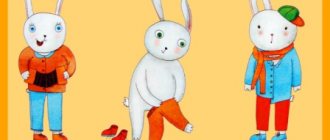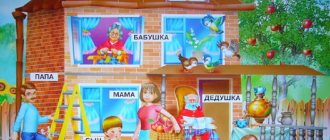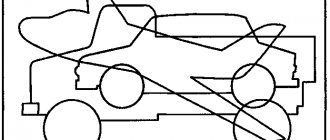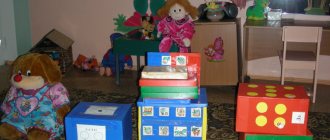Literacy lesson notes. Sound Y, letter Y (Preparatory group)
Literacy training Preparatory group Topic: “Sound Y, letter Y”
Objectives:
Introduce the vowel sound (Y) and its symbol - the letter Y in a red square (or red circle). Develop the ability to correlate the word pattern with the name of the depicted object. To promote the development of sound-letter analysis, phonemic hearing, memory, visual attention, graphic skills, fine motor skills. Cultivate cognitive interest in the subject and accuracy.
Materials and equipment:
handouts: chip, sound ruler, cards for sound analysis, pencils, red felt-tip pen, containers with beans. Demonstration material: image of a letter, magnets, image of the gnome Pykh, pictures of oaks and maples, sound houses. Items: soap, watch, ball. Progress of activities: I. Organizational moment. II. Main part: 1. Relaxation: The teacher turns children into trees “Turn around yourself and turn into trees!” -Imagine that you have turned into oak trees: place your feet firmly on the floor, clench your fists. A strong wind barely sways the large oak trees. They moan in a low voice: “s-s-s.” Now turn into maples. Even a light breeze sways the maples. Raise your relaxed arms and shake them. Maples sing “y-y-y” in a high voice. 2. Isolating the sound (S) from the words: OAKS, MAPLES. Report the topic of the lesson. -How did the oaks and maples moan? What's the last sound? 3. Characteristics of sound based on articulatory and acoustic characteristics. Working with a sound lock. 4. Game “Catch the Sound”. Children clap their hands when they hear words with the sound “Y”: fish, cheese, vacuum cleaner, curtains, tables, clocks. 5.Working with the sound line (individually). Determination of the place of sound (І) in words in three positions: beginning, middle, end of the word. /words: fisherman, soap, rat, noises, balls/. 6. Children hear the sound (P), (Y) - someone puffs (x-x-x). This is the sound of (x) being bored. Add the sound (Х) to the syllable (Пы). what word did you get? (CHUGH). Reading a poem to children: “In the darkest attic lives the shaggy Puff. In the attic, in a draft Among forgotten books. On a summer night in the silence he looks at pictures under the moon. His little eyes are burning, like coals in a fire. It instills fear in sparrows and little mice. But you and I are not afraid of him - After all, he is a GNOME!” - a picture of PIG is hung on the carpet. The teacher invites Pykha to stay with the guys and see what they have learned. Sound analysis of the word “PYKH”. 6. Problem situation: -Are there any words starting with the sound (Y)? “We heard from the owl that there are no words with the sound (Y).” 7. Physical school: “We don’t sleep during the day, We don’t sleep at night. Day and night, we knock, we knock. Tick-tock, tick-tock - all the clocks go like this6 Tick-tock, Left - one!, Right - one. We can do this, tick-tock, tick-tock!” 8. Word formation game: “Come up with a word”: Watch on hand - wrist On the wall - wall On the table - tabletop On the tower - tower
Washing machines - washing machines For cleaning streets - sweepers For transporting goods - trucks For transporting people - cars 9.Work on a proposal. Objects on display: ball, soap, watch. -The name of which object does not contain the sound (Y)?. -Make sentences with the remaining words. For example: Mom bought soap. The clock is ticking quietly. 10. Introducing the letter (Y): “Here is the poor letter Y, wandering around with a stick, alas.” -What elements are in the letter? Laying out a letter from beans, a graphic representation of the letter (in the form of a graphic dictation). III. Bottom line.
General lesson: “Vowel sounds [a], [o], [i], [u], [e], [s]. Letters A, O, I, U, E, Y"
There are mushrooms under the birch trees
They want to jump into the basket!
(at this moment a basket appears)
- Open your eyes, look, someone forgot a basket in the forest!
- Who do you think could have left her here? (children’s answers, music from the film “Masha and the Bear” sounds: the song “About Traces”)
— Did you find out who this hero is? Well, of course, this is Masha!
- Where do you think Masha was in such a hurry that she left her basket? (children's answers)
- Yes, look for Mishka. And Masha was heading towards us, so she left her basket.
- Let's see what Masha brought us. (Children approach the basket and find sound players with different articulations in it)
— The sound guys sit so nicely in the basket, help me recognize them. (The teacher, together with the children, examines the sounds and determines by the articulation of the lips what sound)
— What helped us recognize the sound guys?
- That's right, by the position of the lips. In another way, guys, it’s called ARTICULATION. A new word for you, let’s repeat this word together.
- This, guys, is the work of the speech organs when pronouncing sounds. Let's remember what organs of speech help us pronounce sounds?
- What sounds are these? (vowels)
Why?
(they can be sung, stretched out, and when pronouncing the sounds, the air does not meet any obstacles)
- What color are vowels indicated? (red)
That's why the sound guys always wear red shoes!
- Well done! (sounds are placed on an easel)
— Guys, Masha left “Magic Envelopes” in the basket. Take each envelope and determine by touch what is in them. (If the children do not guess, they can be asked to look through the envelope at the light)
- Arrange the letters to the corresponding sounds. Be careful!
— Guys, what is the difference between a letter and a sound? (we hear and pronounce sounds, and we write and see letters)
III. Introduction to the topic of the lesson.
1. Game “Find a Pair”
- Look how many colorful leaves there are in the forest. Let's collect them in one bouquet. Take one leaf at a time.
— And the leaves are unusual, with pictures on the back.
- Look carefully at what is drawn in your picture and the picture of your neighbor, and think about what sound this word begins with.
- And now we will dance with the leaves to the music, but as soon as the music ends, you must find a pair whose name of the picture begins with the same sound as yours.
— Keep the pictures so that they can be seen. (Children dance with leaves to the music; pairs: watermelon-orange, snail-iron, vegetables-cloud; turkey, popsicle)
)
— Alina and Kirill, what sound unites your couple? Why? (The teacher marks the children who completed the task first and correctly)
— Veronica and Nastya, why didn’t you find a partner? (the names of the pictures begin with different sounds)
Summary of a literacy lesson in the senior group on the topic “Sound [s] and the letter Y”
Svetlana Izotova
Summary of a literacy lesson in the senior group on the topic “Sound [s] and the letter Y”
Summary of a group lesson on teaching literacy to older children
Topic: Sound and letter Y.
Goals:
— introduce children to the articulatory structure of the vowel sound Y;
— develop phonemic hearing, sound-letter analysis skills;
— introduce children to the letter Y;
— teach children to print the letter Y;
- practice the formation of plural nouns;
- develop visual and auditory memory, attention, thinking.
Equipment:
individual mirrors, symbols of vowel sounds, colored and simple pencils, object pictures, cards with the letter Y, Letter - puzzle, teaching aid “A hedgehog walks along the paths”, “Letter City”.
Progress of the lesson
1. Org. moment. Let's remember vowel sounds. Children, together with the speech therapist, repeat the poem:
“There are six vowel sounds in total,
I can sing them all, every single one:
A, O, U, E, I, Y!”
2. Introducing the sound Y.
The speech therapist says the words:
Smoke, full, mouse, cheese, wash, be
-What vowel sound do we hear in these words? - vowel sound Y.
The speech therapist gives a description of the sound, the children pronounce the sound and look at the articulation in the mirrors.
The sound Y is a vowel, sung, pronounced with a voice, the lower jaw is lowered and slightly pushed forward, the Sound Y is indicated by a red chip.
- name words with the sound Y (children name the words and collect the letter puzzle)
3. Development of phonemic hearing. Game "Flashlight".
• Raise the red chip when you hear the sound Y. Children identify the vowel sound Y from a number of vowels:
a, o, s, y, uh, s, a, s, y, uh, s, and, oh, s.
• Raise the red chip if you hear the sound ы (isolating the sound ы from a number of syllables):
ma, we, you, well, ka, py, ba, dy, ve, would
• Raise the red chip if you hear the sound ы (isolating the vowel sound ы from the word):
House, smoke, mustache, be, poppy, bull, moss, echo, melon, teeth, juice, scales.
4. Game “A hedgehog walks along the paths.”
Determining the place of a sound in a word. Children determine the place of the Y sound in words: wasps, balls, cheese, smoke.
Wasps - the Y sound at the end of a word
Balls - the Y sound at the end of a word
Cheese - the sound Y in the middle of a word
Smoke - the sound Y in the middle of a word
Speech therapist: “Now try to name words that begin with the sound Y. “Yes, there are no such words!”
Conclusion:
We heard from the owl
that there are no words starting with the letter Y.
5. Physical exercise.
Children pronounce and clap words, dividing them into syllables.
"We play with words,
We separate them with clapping."
Words: SHA-RY, CHEESE, MA-SHI-NA, W-SHI, TEETH, FISH, SMOKE.
6. Game “One - Many”
I will name one item, and you will name many of these items:
Cat - cats, oak - ... (oaks, catfish - ... (catfish, pancake - ... (pancakes, nose - (noses, table - ... (tables).
7. Introducing the letter Y.
Tracing the contour of the letter Y (tactile cards, coloring the letter with a red pencil, printing the letter with a simple pencil.
8. Summary of the lesson. What letter did we meet today? Introducing the letter Y into the house of vowel sounds (d/p “Bukvograd”).




